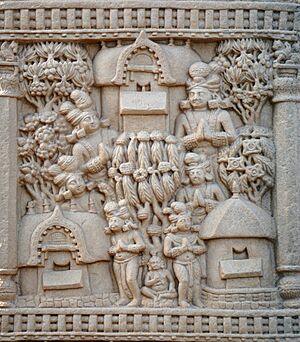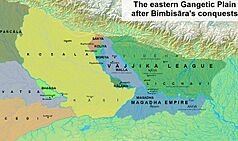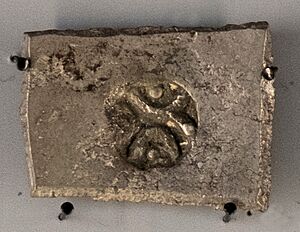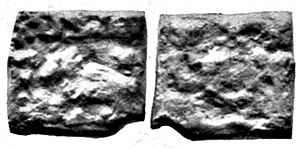Kosala facts for kids
Quick facts for kids
Kingdom of Kosala
कोसल राज्य
|
|||||||||
|---|---|---|---|---|---|---|---|---|---|
| c. 7th century BCE–c. 5th century BCE | |||||||||

Kosala and its neighboring kingdoms.
|
|||||||||
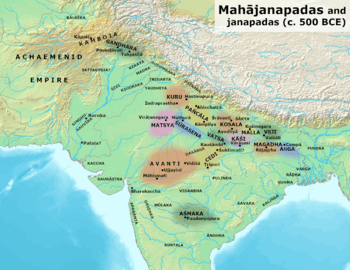
Kosala and the other Mahajanapadas in the Post Vedic period.
|
|||||||||
| Capital | Ayodhya and Shravasti of Uttar Kosala | ||||||||
| Common languages | Sanskrit | ||||||||
| Religion | Historical Vedic religion Jainism Buddhism |
||||||||
| Government | Monarchy | ||||||||
| King | |||||||||
|
• ?
|
Ikshvaku (first) | ||||||||
|
• c. 5th century BCE
|
Sumitra (last) | ||||||||
| Historical era | Iron Age | ||||||||
|
• Established
|
c. 7th century BCE | ||||||||
|
• Disestablished
|
c. 5th century BCE | ||||||||
|
|||||||||
| Today part of | India Nepal |
||||||||
Kosala, also known as Northern Kosala, was an important kingdom in ancient India. It was one of the big states called Mahajanapadas. It started as a small area during the Vedic period. Kosala, along with Magadha, was one of the first places to change from being ruled by families to having a single king. By the 6th century BCE, Kosala became one of the four most powerful kingdoms in northern India. The other powerful kingdoms were Magadha, Vatsa, and Avanti.
Kosala was part of the Northern Black Polished Ware culture. This culture was different from the Painted Grey Ware culture of the nearby Kuru-Panchala region. Kosala developed its own way of life, including cities and using iron. Famous figures like Rama, Mahavira, and the Buddha are believed to have come from the Ikshvaku family, which was important in Kosala.
One of India's two great epic poems, the Ramayana, tells a story set in the Kosala-Videha region. In this epic, the Kosalan prince Rama marries the Videhan princess Sita.
After fighting many wars with its neighbors, Kosala was finally defeated. It became part of the powerful Magadha kingdom in the 5th century BCE. Later, after the Maurya Empire fell, Kosala was ruled by different dynasties. These included the Deva, Datta, and Mitra dynasties.
Contents
Where was Kosala Located?
Geography of Kosala
Kosala was located in a fertile area. The Gomti River was to its west, and the Sarpika River was to its south. The Gandaki River was to its east, separating it from Videha. The Nepal Hills were to its north.
At its largest, Kosala included the lands of several tribes. These tribes were the Shakyans, Mallakas, Koliyas, Kālāmas, and Moriyas. Today, this area roughly matches the Awadh region in India.
Major Cities and Towns
Kosala had three main cities: Ayodhya, Saketa, and Shravasti. It also had smaller towns like Setavya and Ukattha. According to ancient texts like the Puranas and the Ramayana, Ayodhya was the capital of Kosala. This was during the time of King Ikshvaku and his family.
Later, during the Mahajanapada period (6th–5th centuries BCE), Shravasti became the capital. However, kings after the Mauryan period (2nd–1st centuries BCE) minted their coins in Ayodhya.
Culture of Kosala
Kosala was part of the Northern Black Polished Ware culture. This culture existed from about 700 to 300 BCE. Before that, the area had the Black and red ware culture. The Central Gangetic Plain, where Kosala was, was one of the first places in South Asia to grow rice. It also started using iron around 700 BCE.
Historians believe that the Central Gangetic Plain had a unique culture. It was different from the Painted Grey Ware culture to its west. Kosala developed its own cities and started using iron independently.
Religion in Kosala
Kosala was located between the Vedic heartland and the Greater Magadhan culture. The culture of Kosala-Videha was known for its unique Vedic traditions. These traditions included practices like meditation and deep thinking. The Śukla school of the Yajurveda is thought to have originated here.
The Kāṇva school of Vedic traditions was also based in Kosala. This school produced the important Bṛhadāraṇyaka Upaniṣad. Kosala had many "muni" traditions. Munis were spiritual people who practiced yoga, meditation, and lived as wandering beggars. This was different from "ṛṣis" who performed rituals and lived as householders.
The muni tradition included followers of Buddhists, Jains, Ajivikas, and those who worshipped nature spirits like Naga and Yakṣa. There is also evidence of a religion focused on fertility and good fortune. This region was known for its strong female deities and rituals involving sacrifices.
Buddhism in Kosala
Kosala had a very strong connection to the Buddha. The Buddha himself said he was from Kosala. He spent a lot of his time teaching in Śrāvastī. His favorite place to stay was the Jetavana monastery. Early Buddhism was not just a protest against the Vedic-Brahmanical system. It was also against the growing power of Brahmins in that system.
History of Kosala
Early History
The first capital of Kosala, Shravasti, was not very developed by the 6th century BCE. However, there were signs of a mud fort being built. By 500 BCE, Vedic people had spread to Kosala.

By the 5th century BCE, under King Mahakosala, the neighboring Kingdom of Kashi was conquered. King Mahakosala's daughter married King Bimbisara of Magadha. As a wedding gift, Bimbisara received a Kashi village. This marriage helped to reduce tensions between Kosala and Magadha for a while.
During the reign of Mahākosala's son, Pasenadi, Kosala became the ruler of the Kālāma tribal republic. Pasenadi also had good relations with the powerful Licchavi tribe to the east.
Later, a Mallaka general named Bandhula served King Pasenadi. Bandhula and his wife caused trouble with the Licchavikas. This led to fighting between Kosala and the Licchavikas. Pasenadi later had Bandhula and his sons killed. To get revenge, some Mallakas helped Pasenadi's son, Viḍūḍabha, take over the throne of Kosala. Pasenadi then fled and died.
Viḍūḍabha fully took over the Kālāmas during his rule. After the Buddha's death, Viḍūḍabha invaded the Sakya and Koliya republics. He wanted to conquer their lands because they had once been part of Kosala. Viḍūḍabha won this long war, but both sides suffered huge losses. The Sakyas and Koliyas were then absorbed into Viḍūḍabha's kingdom.
Kosala was greatly weakened by its conquest of Sakya. Because of this, it was soon taken over by its eastern neighbor, the kingdom of Magadha. Viḍūḍabha was defeated and killed by the Magadhan king Ajātasattu.
Later, under King Mahapadma Nanda of Magadha, Kosala tried to rebel. However, the rebellion was quickly put down.
Under Mauryan Rule
During the Mauryan Empire, Kosala was likely managed by a viceroy in Kaushambi. An ancient copper plate, probably from the time of Chandragupta Maurya, talks about a famine in Shravasti. It also mentions the relief efforts that officials should take.
An old text called the Yuga Purana mentions an invasion by the Yavana (Indo-Greek) people. This invasion and takeover of Saket happened during the rule of the last Maurya king or Pushyamitra Shunga.
Post-Mauryan Period
We know the names of several Kosalan rulers from the period after the Mauryan Empire. Their square copper coins have been found, mostly in Ayodhya. These rulers belonged to the Deva dynasty. Their names include Muladeva, Vayudeva, Vishakhadeva, Dhanadeva, Naradatta, Jyesthadatta, and Shivadatta.
King Dhanadeva of these coins is believed to be the same King Dhanadeva mentioned in an inscription from Ayodhya. In this inscription, King Kaushikiputra Dhanadeva talks about setting up a flag-staff for his father, Phalgudeva. He also claimed to be the sixth descendant of Pushyamitra Shunga.
Other local rulers whose coins were found in Kosala include those with names ending in "-mitra." These include Satyamitra, Aryamitra, Vijayamitra, and Devamitra. They are sometimes called the "Late Mitra dynasty of Kosala." Other rulers known from their coins are Kumudasena, Ajavarman, and Sanghamitra.
Images for kids
See also
- Kosala Kingdom
- Ayodhya
- Rama
- Prasenjit of Kosala
- Janapada
- Mahajanapada
- Ancestors of Rama
- List of Ikshvaku dynasty kings


